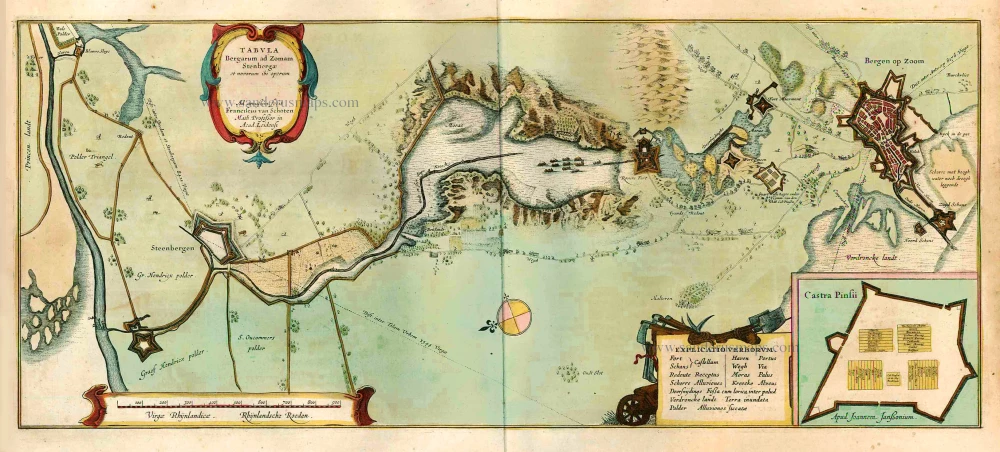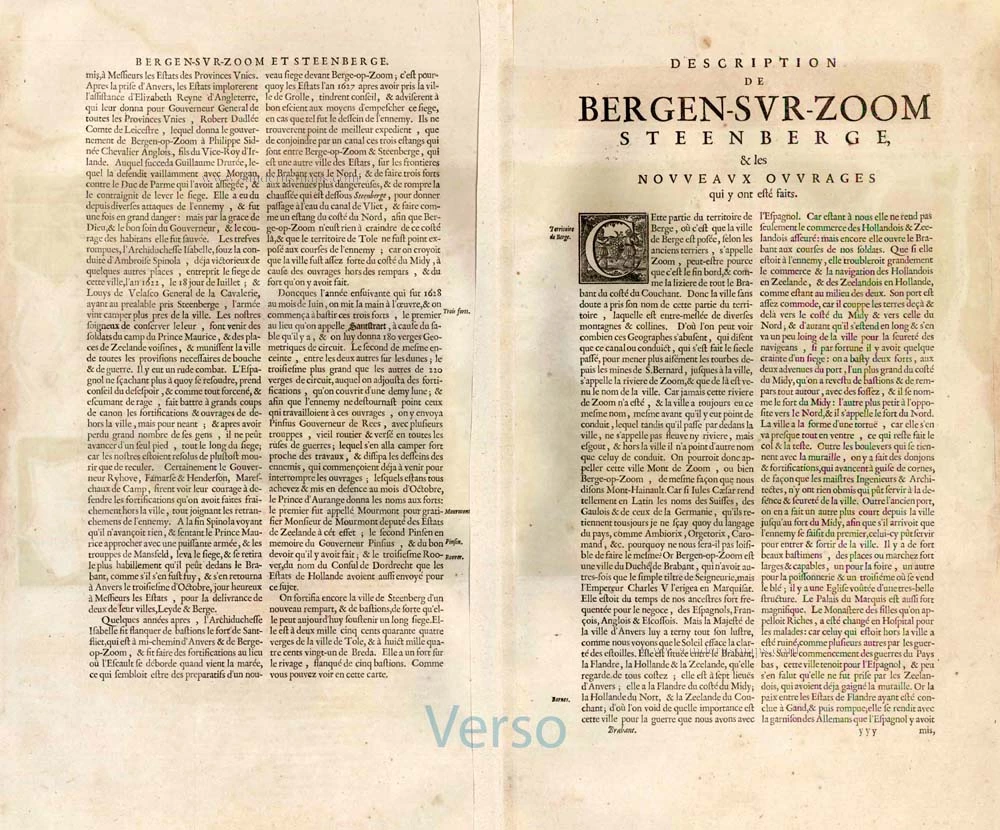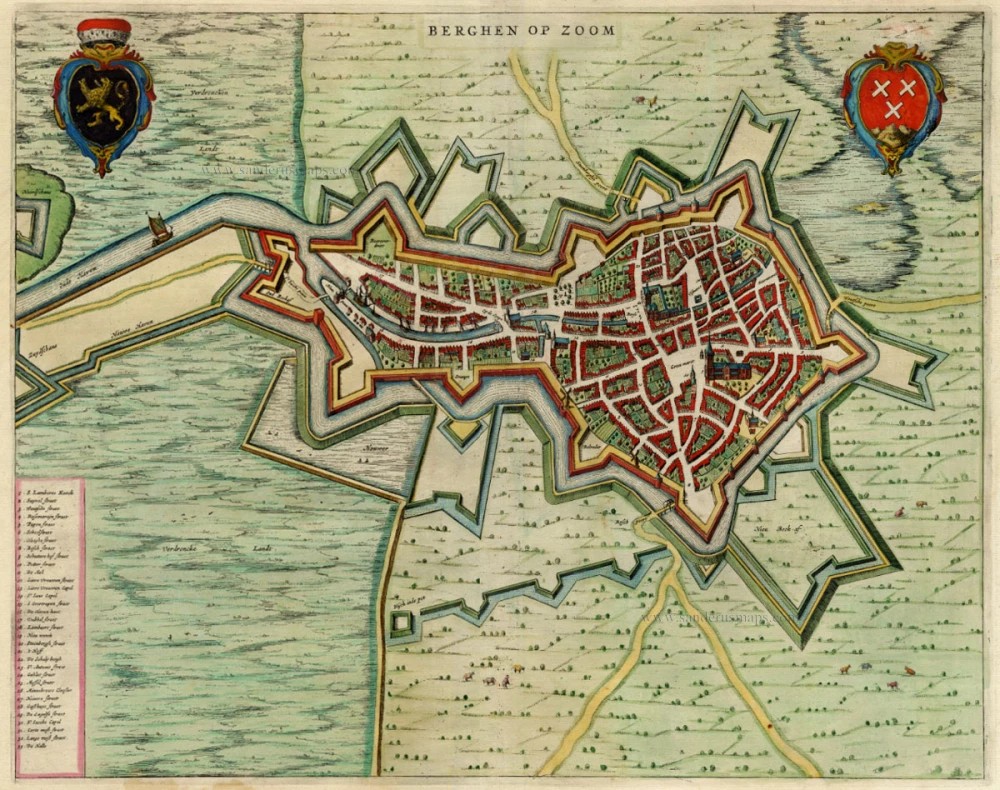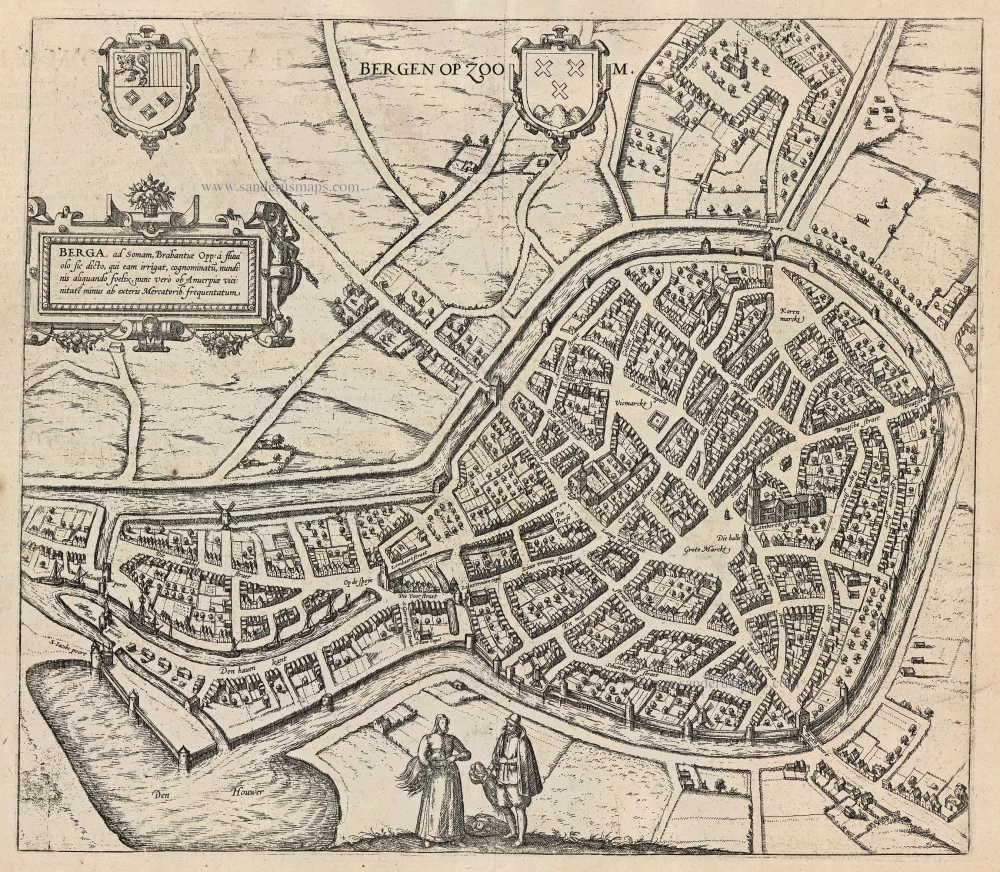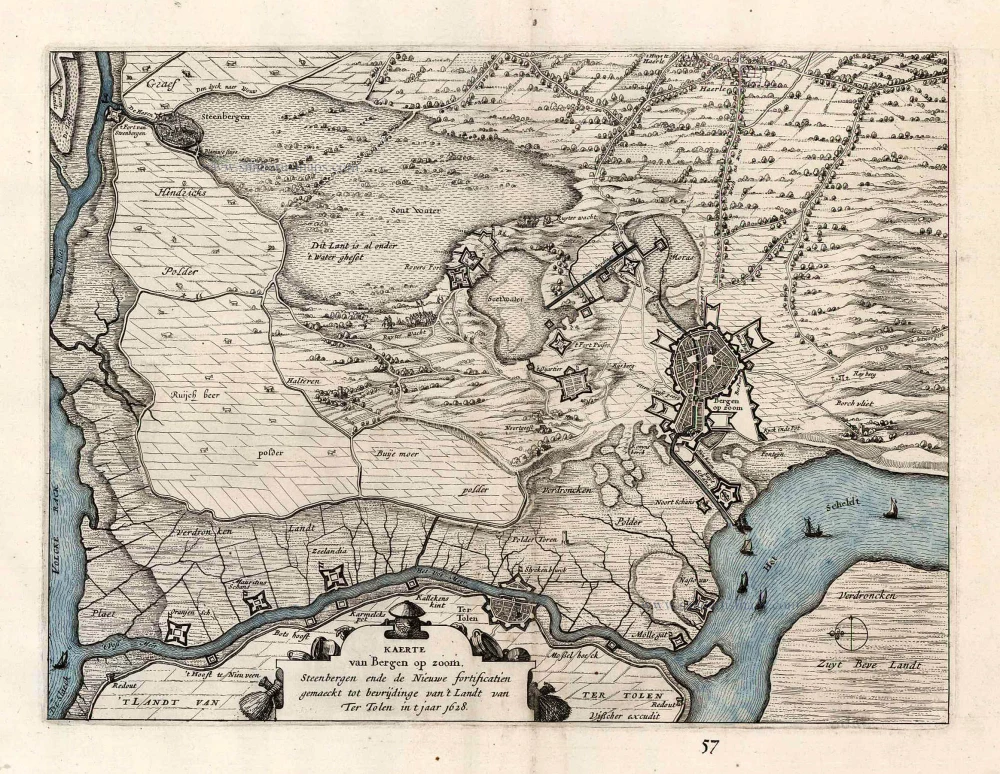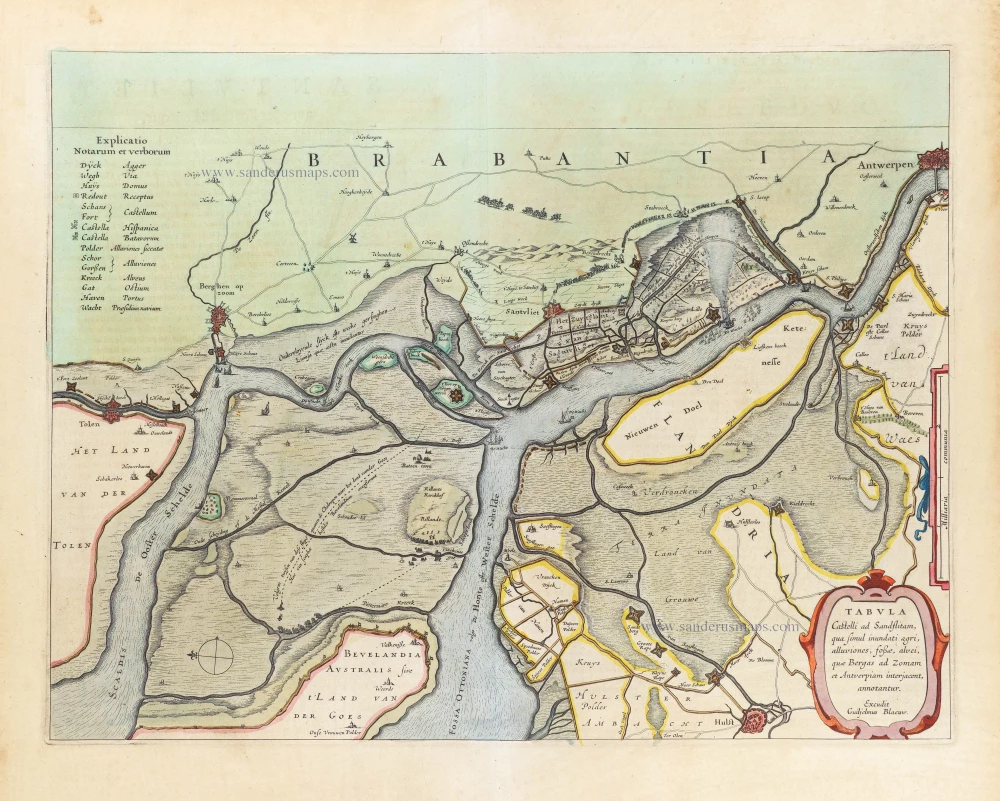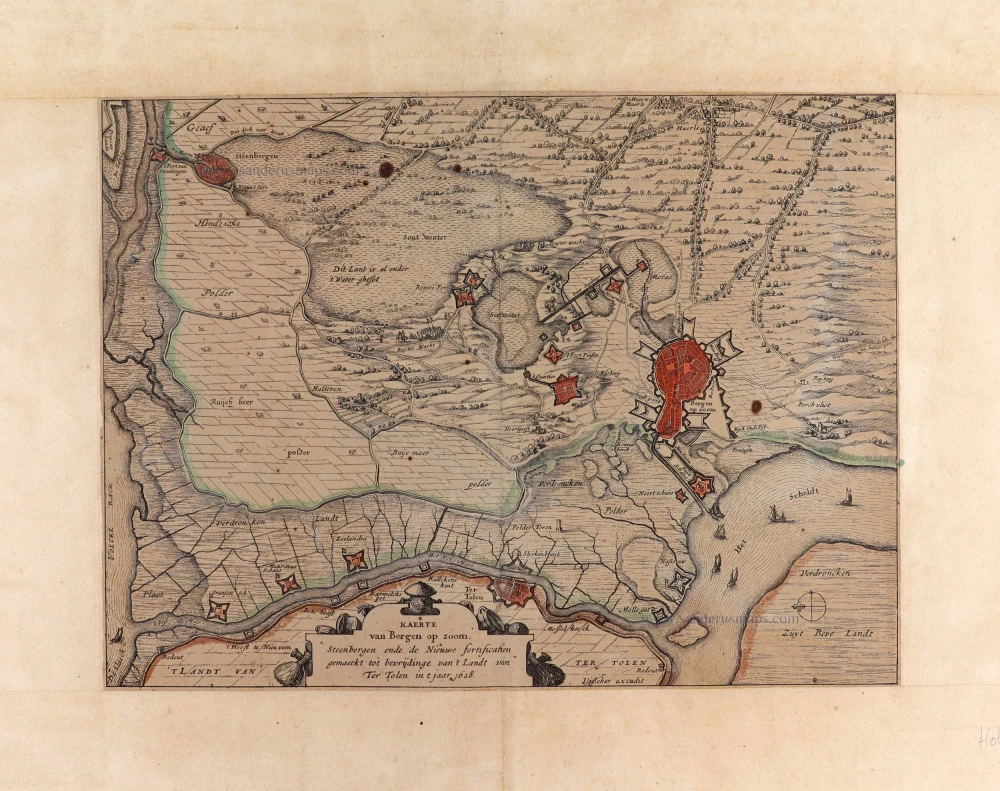Bergen-op-Zoom, by J. Janssonius. 1641
When the archduchess Isabella had the fortification Zandvliet between Bergen-op-Zoom and Antwerp provided with bulwarks and had several fortresses constructed along the Scheldt, the States General decided to build the three forts of Moermont, Pinsen and de Roovere at dangerous points between the swamps to the north of Bergen-op-Zoom. Between these swamps were areas of the higher ground over which the enemy could cross. The new line was supposed to protect Zeeland, the shipping routes between Zeeland and Holland, and the northern front of the city of Bergen against the enemy from the new line of defence in 1628 at the request of Prince Frederick Henry.
The Janssonius Family
Joannes Janssonius (Arnhem, 1588-1664), son of the Arnhem publisher Jan Janssen, married Elisabeth Hondius, daughter of Jodocus Hondius, in Amsterdam in 1612. After his marriage, he settled down in this town as a bookseller and publisher of cartographic material. In 1618, he established himself in Amsterdam next door to Blaeu’s bookshop. He entered into serious competition with Willem Jansz. Blaeu when copying Blaeu’s Licht der Zeevaert after the expiration of the privilege in 1620. His activities concerned the publication of atlases, books, single maps, and an extensive book trade with branches in Frankfurt, Danzig, Stockholm, Copenhagen, Berlin, Koningsbergen, Geneva, and Lyon. In 1631, he began publishing atlases together with Henricus Hondius.
In the early 1640s, Henricus Hondius left the atlas publishing business to Janssonius. Competition with Joan Blaeu, Willem’s son and successor, in atlas production, prompted Janssonius to enlarge his Atlas Novus finally into a work of six volumes, into which a sea atlas and an atlas of the Old World were inserted. Other atlases published by Janssonius are Mercator’s Atlas Minor, Hornius’s historical atlas (1652), the townbooks in eight volumes (1657), Cellarius’s Atlas Coelestis and several sea atlases and pilot guides.
After the death of Joannes Janssonius, the shop and publishing firm were continued by the heirs under the direction of Johannes van Waesbergen (c. 1616-1681), son-in-law of Joannes Janssonius. Van Waesbergen added Janssonius's name to his own.
In 1676, Joannes Janssonius’s heirs sold by auction “all the remaining Atlases in Latin, French, High and Low German, as well as the Stedeboecken in Latin, in 8 volumes, bound and unbound, maps, plates belonging to the Atlas and Stedeboecken.” The copperplates from Janssonius’s atlases were afterwards sold to Schenk and Valck.
Tabula Bergarum ad Zomam Sternbergae et novorum ibi operum.
Item Number: 26307 Authenticity Guarantee
Category: Antique maps > Europe > The Netherlands
Bergen-op-Zoom, by J. Janssonius.
Title: Tabula Bergarum ad Zomam Sternbergae et novorum ibi operum.
With an inset "Castra Pinsii".
Oriented to the southeast.
Date of the first edition: 1630.
Date of this map: 1641.
Copper engraving, printed on paper.
Size (not including margins): 225 x 535mm (8.86 x 21.06 inches).
Verso: French text.
Condition: Original coloured, excellent.
Condition Rating: A+.
From: Nouveau Theatre du Monde ou Nouvel Atlas comprenant Les Tables et Descriptions de toutes les Regions de la Terre. Amsterdam, H. Hondius, 1641. (Van der Krogt 1, 412)
When the archduchess Isabella had the fortification Zandvliet between Bergen-op-Zoom and Antwerp provided with bulwarks and had several fortresses constructed along the Scheldt, the States General decided to build the three forts of Moermont, Pinsen and de Roovere at dangerous points between the swamps to the north of Bergen-op-Zoom. Between these swamps were areas of the higher ground over which the enemy could cross. The new line was supposed to protect Zeeland, the shipping routes between Zeeland and Holland, and the northern front of the city of Bergen against the enemy from the new line of defence in 1628 at the request of Prince Frederick Henry.
The Janssonius Family
Joannes Janssonius (Arnhem, 1588-1664), son of the Arnhem publisher Jan Janssen, married Elisabeth Hondius, daughter of Jodocus Hondius, in Amsterdam in 1612. After his marriage, he settled down in this town as a bookseller and publisher of cartographic material. In 1618, he established himself in Amsterdam next door to Blaeu’s bookshop. He entered into serious competition with Willem Jansz. Blaeu when copying Blaeu’s Licht der Zeevaert after the expiration of the privilege in 1620. His activities concerned the publication of atlases, books, single maps, and an extensive book trade with branches in Frankfurt, Danzig, Stockholm, Copenhagen, Berlin, Koningsbergen, Geneva, and Lyon. In 1631, he began publishing atlases together with Henricus Hondius.
In the early 1640s, Henricus Hondius left the atlas publishing business to Janssonius. Competition with Joan Blaeu, Willem’s son and successor, in atlas production, prompted Janssonius to enlarge his Atlas Novus finally into a work of six volumes, into which a sea atlas and an atlas of the Old World were inserted. Other atlases published by Janssonius are Mercator’s Atlas Minor, Hornius’s historical atlas (1652), the townbooks in eight volumes (1657), Cellarius’s Atlas Coelestis and several sea atlases and pilot guides.
After the death of Joannes Janssonius, the shop and publishing firm were continued by the heirs under the direction of Johannes van Waesbergen (c. 1616-1681), son-in-law of Joannes Janssonius. Van Waesbergen added Janssonius's name to his own.
In 1676, Joannes Janssonius’s heirs sold by auction “all the remaining Atlases in Latin, French, High and Low German, as well as the Stedeboecken in Latin, in 8 volumes, bound and unbound, maps, plates belonging to the Atlas and Stedeboecken.” The copperplates from Janssonius’s atlases were afterwards sold to Schenk and Valck.

